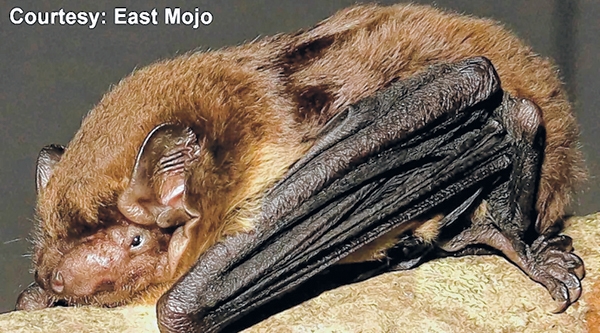Twelve new bat records found during survey
|

GUWAHATI, Oct 4
Researchers from the Zoological Survey of India have reported on 12 new records of bats during a study on small mammalian fauna in Manipur.
The study has been published in the Journal of Threatened Taxa.
Three mammalian orders – Chiroptera, Rodentia, and Eulipotyphla – constitute the bulk of small mammalian species. In spite of their diversity, numerical preponderance, and widespread distribution, they are the least explored mammals with serious information gaps on diversity and distribution, especially in the context of North East India.
The researchers–Uttam Saikia and AB Meiteei–conducted two extensive field surveys covering nine districts of Manipur in 2019 and 2021 resulting in the collection of 62 examples of these groups. Besides, 12 additional examples of bats and shrews from Manipur were deposited at the North Eastern Regional Centre (NERC) of ZSI, Shillong.
Most of the publications pertaining to the small mammalian fauna of Manipur State are old and new studies on this group in the State are far and few.
The 12 new records of bats are – Hipposideros cineraceus (Ashy Roundleaf Bat), Rhinolophus affinis (Intermediate Horseshoe Bat), Rhinolophus lepidus (Blyth’s Horseshoe Bat) Rhinolophusc macrotis (Blyth’s Horseshoe Bat), Rhinolophus perniger (Northern Wooly Horseshoe Bat), Lyroderma lyra (Greater False Vampire Bat), Myotis annectans (Hairy-Faced Bat) Myotis formosus (Hodgson’s bat), Murina huttonii (Huton’s Tube-nosed Bat), Murina cyclotis (Round-eared Tube-nosed Bat, Mirostrellus joffrei (Joffrei’s Pipistrelle) and Hipposideros gentilis (Andersen’s Roundleaf Bat).
Based on these voucher records and field evidence, the researchers reported the presence of 38 species of small mammals from the State including 27 species of bats, 10 species of rodents and one species of shrew. Out of these, 12 species of bats have been recorded for the first time in the State.
“It is expected that the present inventory will expand with further surveys as fossorial rodents and shrews were not adequately sampled during the present studies,” the study said.
Two surveys were conducted covering nine districts in the State between September 30, 2019, and October 18, 2019, and October 11, 2021, to October 26, 2021. Due to the Covid-19 pandemic-induced situation, the scheduled survey in 2020 could not be undertaken. Twenty-four localities representing a mix of dry deciduous forests, semi-evergreen forests, subtropical pine forests, caves and caverns and around human habitations were surveyed.
For collecting bat samples, mist nets and a two-bank harp trap were utilized whereas for rodents and shrews, several foldable Sherman traps were used. Opportunistic collections were also made inside a few of the prominent caves and from human dwellings using a collapsible butterfly net.
Globally, bats are under threat from severe human pressure like habitat destruction and degradation, over exploitation, persecution etc. and the situation is no different in India.
“Khangkhui cave in Ukhrul district is a well–known tourist destination in the State. We were told by the local guides that until 2016-17, the cave used to hold large roosting populations of Rhinolophid and Hipposiderid bats. But they were all killed and evicted from the cave in recent times purportedly to make the cave “more tourist-friendly”, the study says.
The study says in some places, bats are also eaten for their supposed medicinal properties or as a supplementary source of protein. In Wailou village in Chandel district, we were informed that people do occasionally hunt bats in a nearby cave although this practice is not widespread throughout the State.
The researchers say, fortunately, a certain level of awareness about wildlife conservation has been growing in some areas in recent times. “Special mention worthy is Dailong village in Tamenglong district which has been at the forefront of community-led conservation efforts.
The forests in and around Dailong village have rich biodiversity and for generations, people have been protecting these forests as their heritage,” they said.
The researchers said the same level of awareness is needed and wisdom spread to far-flung areas where enforcement of wildlife laws is inherently difficult. “This is indeed a huge challenge, but the onus primarily lies with the Government who can rope in community leaders, youth organizations, and non-Governmental organizations. This should be one of the priorities of the State Government and they should take steps before it is too late to act,” the researchers stated in the study.
East Mojo

